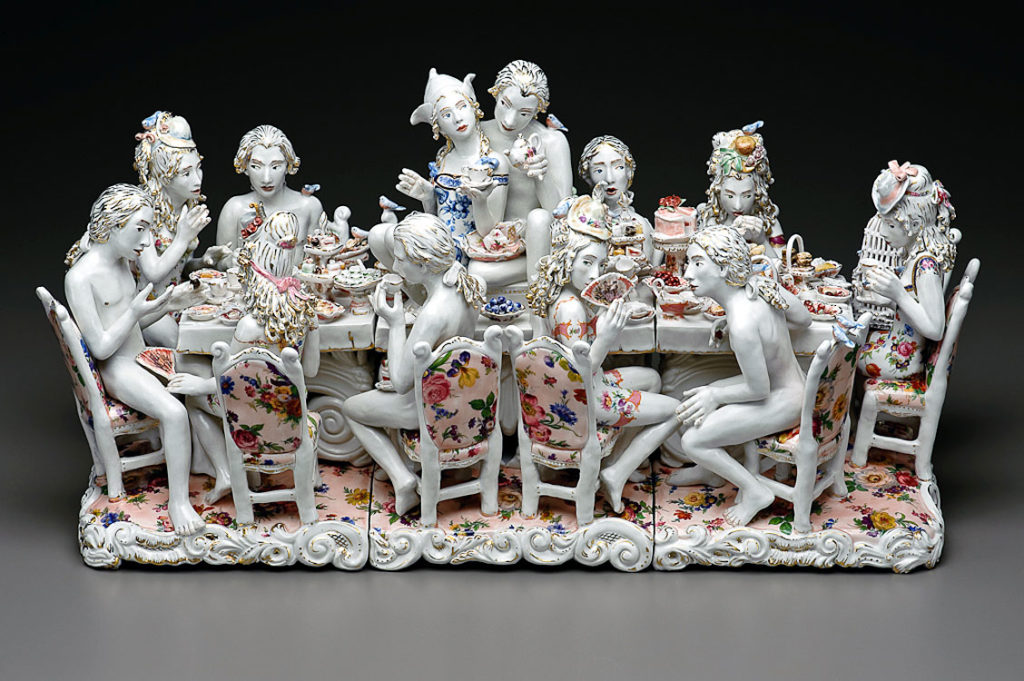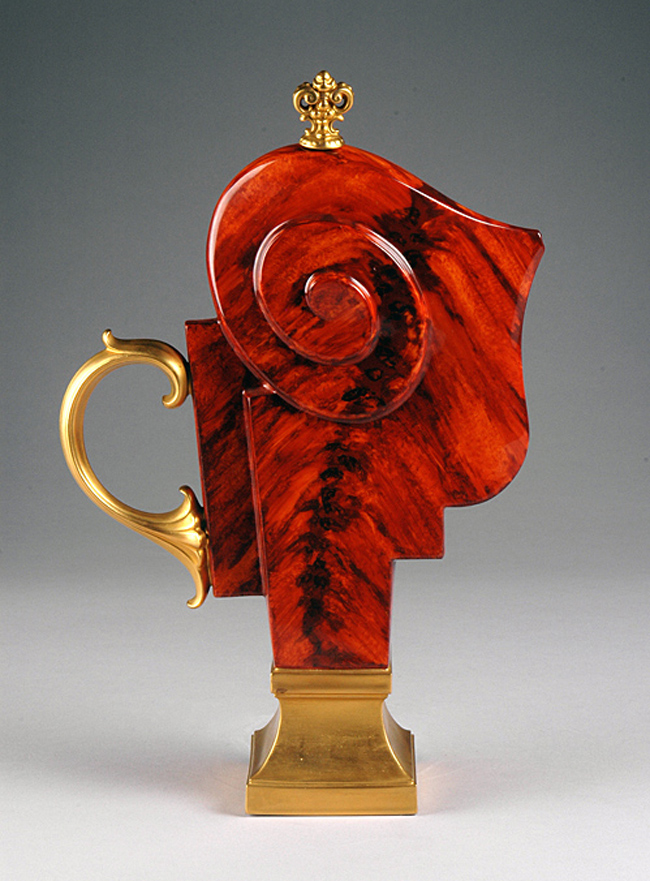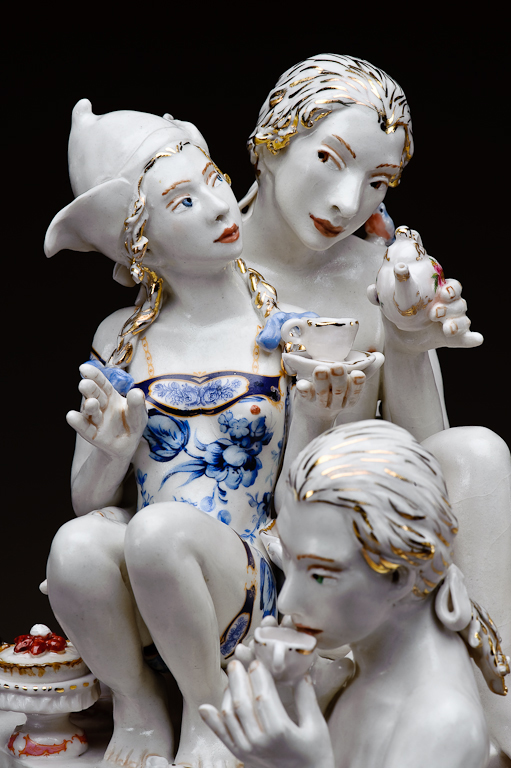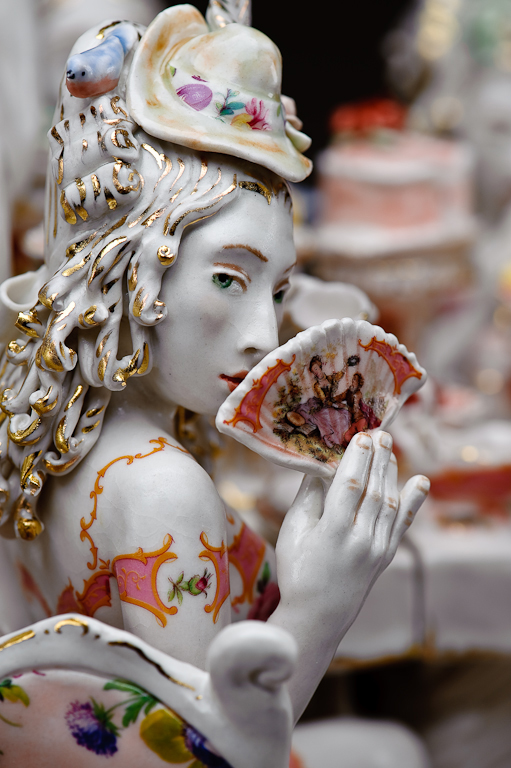The Kamm Teapot Collection contains numerous contemporary works in clay that look to historical ceramic traditions for inspiration. These designs might contain reflections of ancient Chinese pottery or perhaps eighteenth century French porcelain, but they also wholeheartedly exhibit their creator’s “own twists and personality.”[i] Cindy Sherman, Michelle Erickson, Adrian Saxe, and Chris Antemann, all of whom are represented in the Kamm’s collection, have utilized this approach with their work. For the purposes of this blog post, we will take a closer look at two of these talented artists: Adrian Saxe and Chris Antemann.
Adrian Saxe (American, born 1943)
Adrian Saxe is known for his vessels that blend an array of historical ceramic practices from across the globe with elements of contemporary culture. Often with a “scholar’s wit,” his work has ranged from a sumptuous series of gourd-shaped forms that mimic eighteenth century French porcelain to a selection of ampersand ewers that are inspired by antique Asian wine pots.[ii] A Saxe vessel “aggressively projects [his] sensibilities and formal interests while extending and critiquing the intellectual and formal traditions of art.”[iii]
Born in Glendale, California, Saxe’s parents “taught their son craft techniques and respect for artistic, handmade objects.[iv] Clay, in particular, captured his attention. After some early explorations with the medium, Saxe enrolled at the Chouinard Art Institute in Los Angeles in 1965 and later, he received a B.F.A. degree from the California Institute of the Arts, Valencia.[v] At the Chouinard Art Institute Saxe studied under acclaimed ceramicist Ralph Bacerra. Originally, he had planned to study with Peter Voulkos at the University of California, Berkeley. However, a car accident delayed his enrollment.[vi] It has been suggested that this change of course was “fortuitous” for Saxe since the “Voulkos energy was past its peak.”[vii] Instead, he experienced the emergence of two artistic developments: the Bay Area Funk movement and the “Los Angeles look” or “Fetish Finish” style.[viii] While he did not fully adopt these approaches, they inspired his use of “visual and verbal puns” and his openness to explore new materials and techniques.[ix] Most importantly, as Saxe was beginning his career, the barriers between art and craft were being tested, especially with clay. This had a lasting impact. Saxe’s work does not fit into one artistic category. He is often recognized for his ability to extend “beyond craft considerations to make serious statements about both ceramics and art.”[x]
In 1983 Saxe was awarded a fellowship and a six-month residency at the experimental atelier of the Manufacture Nationale de Sèvres in France.[xi] While at this renowned factory, he gained invaluable knowledge of soft paste porcelain, mold-making, and gilding. This experience reinforced Saxe’s interest in past ceramic styles as well as their construction techniques.
Saxe is well represented in the Kamm Collection. As you explore these works you will see scrolling forms, rich surfaces, and humor as well as references to contemporary culture and historical periods. Among these designs, there is also a teapot sculpture made during Saxe’s second fellowship at Sèvres. He returned in 1987 for an exchange fellowship between the United States Information Agency and the Association Dialog Entre les Cultures. This abstract teapot sculpture Untitled Théière, which is made of soft porcelain, is coated in a faux wood grain pattern and 24K gold. According to Sèvres, this work is a variant of the eighteenth century’s soft porcelain which was redeveloped around 1980.
A Los Angeles Times article from 1991 stated that Saxe “uses clay to bridge the long-separated worlds of art and craft.”[xii] Indeed, with “an eclecticism tied to the contemporary experience,” his work has thrived “betwixt and between” these domains and continues to do so.[xiii] Saxe retired in 2018 from the University of California, Los Angeles, where he taught for forty-five years. His work is found in numerous museum collections including New York’s Metropolitan Museum of Art and the Smithsonian American Art Museum in Washington, D.C.
CHRIS ANTEMANN (AMERICAN, BORN 1970)
Chris Antemann has received widespread recognition for her intricate figurative sculptures “that celebrate the European porcelain figurine and the history surrounding eighteenth century dining culture.”[xiv] Arranged in “cheerful” scenes such as “elaborate dinner parties, picnic luncheons, and ornamental gardens,” the figures in her work seem to convey a “frivolous zest for life.”[xv] However, upon closer inspection, Antemann actually creates parodies of this world.[xvi] Her sculpture, which is “ambiguous, provocative, and frequently erotic,” utilizes these decadent scenes to explore male and female relationship roles in a contemporary manner.[xvii]
Antemann’s exposure to seventeenth and eighteenth century music and art began in childhood. While growing up in Western Pennsylvania, she listened to chamber music, particularly the string quartets of Mozart or Beethoven, and experienced “the beguiling scenes of pleasure and scandal painted by [François] Boucher, [Jean-Honoré] Fragonard, and [Jean-Antoine] Watteau.”[xviii] In college Antemann deepened her studies of this period and at the University of Minnesota, Minneapolis figurines from the eighteenth century became the focus of her Master’s thesis.[xix] These Rococo styled forms, with their “sparkling colors, exquisite details, and rich decoration,” fascinated her.[xx] In fact, they have had an impact on her work ever since.
After graduate school, Antemann decided to further explore her interest in figurines through a series of immersive experiences. She accepted an Artist in Residence position at the Jingdezhen Sanbao Ceramic Art Institute in Jingdezhen, China and was the Arts/Industry Resident at the John Michael Kohler Factory in Sheboygan, Wisconsin. Then in 2010, Antemann was presented with the opportunity to work with Meissen, Europe’s oldest porcelain factory located in Germany.[xxi] This collaboration with Meissen’s artCAMPUS has produced numerous large one-of-a-kind and limited-edition sculptures.
Within the Kamm Collection there is an Antemann sculpture from 2010, the year before her collaboration with Meissen. Called Battle of the Britches: The Tea Party, this porcelain work is decorated with decals and a luster glaze. It features a large party of nude figurines seated around a long table covered with food and dishes. The men’s genitals are judiciously shielded, and the women, who are wearing hats, have ornamental patterns decorating their torsos. Battle of the Britches: The Tea Party reflects Antemann’s characteristic style and approach. At first glance, the sculpture seems to simply capture and reflect the spirit of eighteenth century porcelain. However, in reality, it is something quite different. Antemann is known to play with “social norms, etiquette, and taboos.”[xxii] Frequently she “reverses the role of men and women – and always with a mischievous slant that is typical of her work.”[xxiii]
Antemann’s partnership with the Meissen factory continues today. Her largest installation called Forbidden Fruit: Chris Antemann at Meissen, which traveled for three years in the United States, was on view this summer at the State Hermitage Museum in St. Petersburg, Russia.
Further Reading/Viewing:
Albicker, Valerie. “What Follows” Interview Series: Adrian Saxe. 10 September 2012.
Clark, Garth. The Artful Teapot. London: Thames & Hudson, 2001.
Forbidden Fruit: A Collection of Antemann Dreams, Contemporary Sculptural Art for Collectors. Meissen, Germany: Staatliche Porzellan-Manufaktur Meissen GmbH, 2013.
Lynn, Martha Drexler. The Clay Art of Adrian Saxe. New York, NY: Thames and Hudson, Inc., 1993.
UCLA Department of Art Lectures: Adrian Saxe. Hammer Museum. 17 May 2012.
SOFA Expo. Chris Antemann.
Notes:




